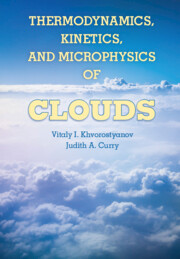Book contents
- Frontmatter
- Contents
- Preface
- 1 Introduction
- 2 Clouds and Their Properties
- 3 Thermodynamic Relations
- 4 Properties of Water and Aqueous Solutions
- 5 Diffusion and Coagulation Growth of Drops and Crystals
- 6 Wet Aerosol Processes
- 7 Activation of Cloud Condensation Nuclei into Cloud Drops
- 8 Homogeneous Nucleation
- 9 Heterogeneous Nucleation of Drops and Ice Crystals
- 10 Parameterizations of Heterogeneous Ice Nucleation
- 11. Deliquescence and Efflorescence in Atmospheric Aerosols
- 12 Terminal Velocities of Drops and Crystals
- 13 Broad Size Spectra in Clouds and the Theory of Stochastic Condensation
- 14 Analytical Solutions to the Stochastic Kinetic Equation for Precipitating Clouds
- References
- Notations
- Index
13 - Broad Size Spectra in Clouds and the Theory of Stochastic Condensation
Published online by Cambridge University Press: 05 September 2014
- Frontmatter
- Contents
- Preface
- 1 Introduction
- 2 Clouds and Their Properties
- 3 Thermodynamic Relations
- 4 Properties of Water and Aqueous Solutions
- 5 Diffusion and Coagulation Growth of Drops and Crystals
- 6 Wet Aerosol Processes
- 7 Activation of Cloud Condensation Nuclei into Cloud Drops
- 8 Homogeneous Nucleation
- 9 Heterogeneous Nucleation of Drops and Ice Crystals
- 10 Parameterizations of Heterogeneous Ice Nucleation
- 11. Deliquescence and Efflorescence in Atmospheric Aerosols
- 12 Terminal Velocities of Drops and Crystals
- 13 Broad Size Spectra in Clouds and the Theory of Stochastic Condensation
- 14 Analytical Solutions to the Stochastic Kinetic Equation for Precipitating Clouds
- References
- Notations
- Index
Summary
Introduction
The characteristics and evolution of the cloud droplet and crystal size spectra determines cloud radiative properties and the formation of precipitation. Accounting for these processes in cloud-resolving models and climate models requires correct understanding and then parameterization of cloud microstructure and its dependence on predicted atmospheric parameters. During the past five decades, cloud physics and cloud optics have widely used empirical parameterizations of cloud particle size spectra such as the gamma distributions or exponential spectra described in Chapter 2.
These empirical spectra were used in the remote sensing of clouds and also in the modeling and parameterization of cloud properties and processes, both in the cloud-resolving models (CRM) and in some advanced general circulation models (GCMs). A new impetus for bulk microphysical models was given during the past two decades by development of the double-moment bulk schemes that include prognostic equations for the number concentrations of hydrometeors in addition to the mixing ratio, which allows a higher accuracy in predicting the cloud microphysical properties. The double moment schemes are used in cloud models (e.g., Ferrier, 1994; Harrington et al., 1995; Meyers et al., 1997; Cohard and Pinty, 2000; Girard and Curry, 2001; Seifert and Beheng, 2001, 2006; Morrison et al. 2005a,b; Milbrandt and Yau, 2005a,b). These schemes are also incorporated into advanced mesoscale weather prediction models such as the Weather Research and Forecast (WRF) model (e.g., Morrison et al. 2005a,b) and the weather prediction Consortium for Small-Scale Modeling (COSMO) model (e.g., Zubler et al., 2011). The most advanced general circulation models (GCMs) also began using such double-moment microphysics parameterizations that were included earlier only in cloud-resolving models (e.g., Sud and Lee, 2007; Morrison and Gettelman, 2008; Sud et al, 2009). These parameterizations are also based on using gamma distributions or exponential spectra with prescribed parameters.
- Type
- Chapter
- Information
- Thermodynamics, Kinetics, and Microphysics of Clouds , pp. 613 - 684Publisher: Cambridge University PressPrint publication year: 2014



